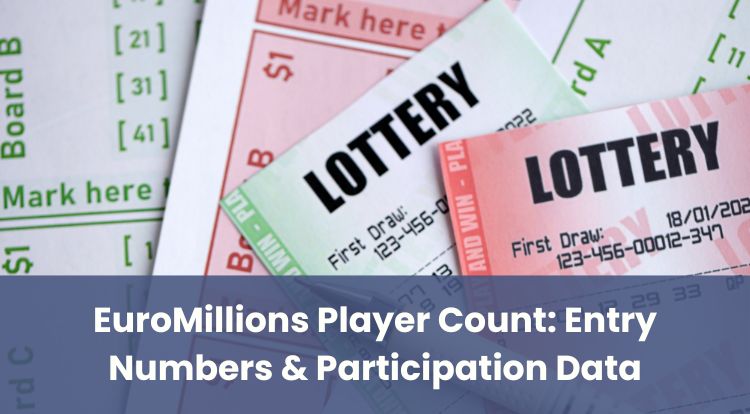
EuroMillions is a familiar part of life in the UK, with regular draws that many people know about and follow. While the big jackpots often make the headlines, there’s also an interesting story in the background – the number of entries, how participation changes from week to week, and what that says about the game as a whole.
If you take part now and again, or you’re simply curious about how many others do, looking at these figures could give some useful perspective. By looking at the participation data, it’s easier to see how player numbers shape each draw and what they reveal about the wider picture.
How Many People Play EuroMillions?
EuroMillions entries often reach striking totals each Tuesday and Friday. In the UK, it is common for 4 to 6 million tickets to be sold for a single draw, with participation rising when the jackpot has rolled over and grown. Across all participating countries, the combined number of individual lines regularly sits somewhere between 30 and 50 million per draw.
Those figures highlight just how widespread interest is, with many UK adults taking part at least occasionally. Tickets are available from retailers and official online channels that hold a UK licence, making it straightforward to enter when you fancy a chance in the draw.
If you decide to participate in the Euromillions, remember to do so responsibly and within your means; never wager more than you can afford to lose.
Average Ticket Sales and Participation Rates
On an average draw in the UK, sales usually land in the 4 to 6 million range, though they can climb quickly when the top prize is higher than usual. These totals include everything from one-off lines to multi-draw purchases, whether bought in shops or online.
Many players join syndicates, which pool entries and share any prizes. Over a year, roughly half of UK adults take part in at least one lottery game, and EuroMillions tends to attract strong interest because it brings several countries together into one draw. The appeal is steady, but the numbers naturally move around from draw to draw depending on what is happening that week.
Looking beyond the UK helps explain why those ups and downs vary by market.
Differences in Player Numbers Across Countries
EuroMillions is available across nine participating countries, and the level of participation tends to reflect both population size and local playing patterns. In the UK, around 4 to 6 million tickets are usually entered into each draw, making it one of the larger contributors. France and Spain also record high levels of participation, supported by their larger populations and the presence of long-standing national lottery traditions.
In smaller countries, such as Luxembourg or Austria, the number of entries is naturally lower, simply because there are fewer people taking part. Even so, the combined entries from all participating nations create a substantial overall pool, with each country’s contribution varying depending on population and weekly engagement.
What Affects the Number of EuroMillions Players?
Several elements shape how many people get involved in any draw. The size of the jackpot is the most visible driver, with bigger advertised totals pulling in extra entries from occasional and regular participants alike.
Timing matters too. Draws that fall near pay day, during school breaks or around major holidays often see more interest. Special events, such as draws with boosted prize funds or added raffles, can also nudge participation higher for a short spell.
Accessibility plays its part. With thousands of retailers and straightforward online buying options, it is simple to enter when you want to. In the UK, tickets are sold through licensed channels, which keeps processes consistent and secure.
EuroMillions Rollovers and Their Impact on Participation
A rollover happens when no ticket matches all five main numbers and both Lucky Stars. When that occurs, the jackpot moves to the next draw and increases. As the prize grows, more people tend to take part, and UK sales can rise by hundreds of thousands of entries compared with a standard starting jackpot.
If rollovers continue, the jackpot can reach very high levels. EuroMillions has a cap that limits how large the top prize can become. At present, the cap is €250 million, which is roughly £213 million, and it keeps the game within agreed parameters across participating countries.
With rollovers in mind, it becomes easier to read what the player counts are signalling from one draw to the next.
How Player Count Data Helps Understand the Game
Participation figures help explain patterns that sit beneath the headlines. When more people enter a draw, the overall prize fund usually grows, and that can influence the amounts paid at lower and mid-level prize tiers that are shared among all winners in those categories.
Player numbers also give a sense of how often prizes might be shared. If millions of tickets are in play, the chance of more than one winner in a given tier is naturally higher, which can affect how payouts are divided. It is not about changing the underlying odds of the game, but about how outcomes are shared when they occur.
These figures are monitored so that draws run to the rules and sales channels follow UK Gambling Commission (UKGC)-licensing requirements. Understanding how many people take part, and why those counts move around, offers a clearer view of the game’s scale and how each draw sits within the wider picture.
**The information provided in this blog is intended for educational purposes and should not be construed as betting advice or a guarantee of success. Always gamble responsibly.
*All values (Bet Levels, Maximum Wins etc.) mentioned in relation to these games are subject to change at any time. Game features mentioned may not be available in some jurisdictions.
